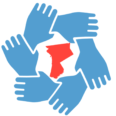How to Tell if Your Baby is Choking
A choking baby:
- Cannot cry, cough, or make sounds
- May have a scared look on their face
- May turn blue or purple around the lips
- Cannot breathe
Quick Steps for a Choking Baby
If Your Baby Can Cough:
- Let them cough – their body is trying to clear the airway
- Stay with them and watch closely
- Do not pat their back or try to remove the object if they are coughing
If Your Baby Cannot Cough or Breathe:
- Call 911 right away (or have someone else call)
- Place baby face down on your forearm
- Support their head and neck with your hand
- Keep their head lower than their body
- Give 5 back blows (hits) between the shoulder blades using the heel of your hand
If the object doesn’t come out:
- Turn baby over onto their back (still on your arm)
- Place two fingers in the middle of their chest just below the nipple line
- Give 5 quick chest thrusts (pushes), about 1 per second
- Keep going between 5 back blows and 5 chest thrusts until:
- The object comes out, OR
- Baby starts to breathe or cough, OR
- Baby becomes unconscious (passes out)
CPR for Babies (If Not Breathing)
If your baby is not breathing:
- Call 911 (or have someone else call)
- Place baby on a flat, hard surface
- Check for breathing – look at chest movement for 5-10 seconds
- If not breathing, start CPR:
Step 1: Open the Airway
- Place one hand on the forehead
- Gently tilt the head back a little (not too far)
- Lift the chin with two fingers of your other hand
Step 2: Give 2 Rescue Breaths
- Cover baby’s mouth AND nose with your mouth
- Give 2 small gentle breaths (1 second each)
- Watch for chest to rise with each breath
Step 3: Give Chest Compressions
- Place two fingers in the middle of the chest, just below the nipple line
- Push down about 1.5 inches (about 1/3 of the chest depth)
- Push at a rate of 100-120 compressions per minute (about 2 per second)
- Let the chest come back up between each push
- Do 30 compressions
Step 4: Repeat
- Continue with 2 breaths followed by 30 compressions
- Keep doing this until:
- The baby starts breathing, OR
- Help arrives, OR
- You are too tired to continue
Important Things to Remember
- Learn CPR before you need it if possible (Call 211 to inquire about opportunities to learn CPR in the community)
- Stay calm (babies can sense your fear)
- Call 911 first or have someone else call while you help your baby
- Even if your baby seems fine after choking, call their doctor
- Take a CPR class to practice these skills
When to Call 911
Call 911 right away if your baby:
- Is choking and cannot breathe
- Becomes unconscious (passes out)
- Turns blue or purple
- Is not breathing
How to Prevent Choking
- Always watch your baby during meals
- Cut food into tiny pieces (smaller than a pea)
- Avoid round, hard foods like grapes, nuts, popcorn, and hard candy
- Check toys for small parts that could break off
- Keep small objects off the floor and away from baby
- Never prop a bottle or give food to a baby lying down
References
- American Academy of Pediatrics. (2022). First Aid for Choking. HealthyChildren.org.
- American Heart Association. (2021). Infant CPR and Choking. heart.org.
- American Red Cross. (2022). Pediatric First Aid/CPR/AED. redcross.org.
- Centers for Disease Control and Prevention. (2021). Choking Prevention for Children. cdc.gov.
- Mayo Clinic. (2022). Choking: First Aid. mayoclinic.org.
- Stanford Children’s Health. (2021). Safety for Your Child: 6 to 12 Months. stanfordchildrens.org.


